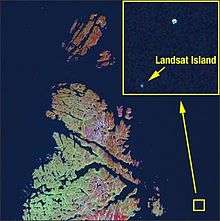Landsat Island

Landsat Island is a small, uninhabited island located 20 km off the northeast coast of Labrador (part of the Canadian province of Newfoundland and Labrador). It was discovered in 1976[1] during the analysis of imagery from the Landsat 1 satellite. Its total area is only 25 m by 45 m (1,125 m²).
Discovery
In 1976, a Canadian coastal survey was carried out using data from the Landsat 1 satellite. Analysis of the data revealed several previously uncharted features; this includes Landsat Island, which was subsequently named after the satellite. Verification of the island's existence fell to Dr. Frank Hall of the Canadian Hydrographic Service:
[Dr. Hall] was strapped into a harness and lowered from a helicopter down to the island. This was quite a frozen island and it was completely covered with ice. As he was lowered out of the helicopter, a polar bear took a swat at him. The bear was on the highest point on the island and it was hard for him to see because it was white. Hall yanked at the cable and got himself hauled up. He said he very nearly became the first person to end his life on Landsat Island.— From Scott Reid's account of Dr. Hall's Landsat Island expedition given to the Canadian Parliament
Following Dr. Hall's encounter with the polar bear, it was suggested that the island be named "Polar Island,"[2] but the present name was retained.
Landsat Island marks the easternmost point of the Canadian land mass along this section of the Labrador coast. As such, its discovery increased Canada's maritime territory by 68 km².
Flora and fauna
As experienced by Dr. Hall, it appears that polar bears frequent the island. As of 2014, no extensive studies of flora or fauna have been conducted there.
References
- ↑ Gray, David H. (Summer 2000). "Discovering Rocks Off Labrador: A Photo Essay" (PDF). IBRU Boundary and Security Bulletin: 89, 99. Retrieved 2013-07-15.
- ↑ Rocchio, Laura (April 19, 2006). "Landsat Island". National Aeronautics and Space Administration. Retrieved 2013-07-15.
External links
- NASA article: Landsat Island (April 19, 2006)
- David H. Gray, "Discovering Rocks off Labrador: A Photo Essay", IBRU Boundary and Security Bulletin, Summer 2000.
Coordinates: 60°10′37″N 64°2′30″W / 60.17694°N 64.04167°W